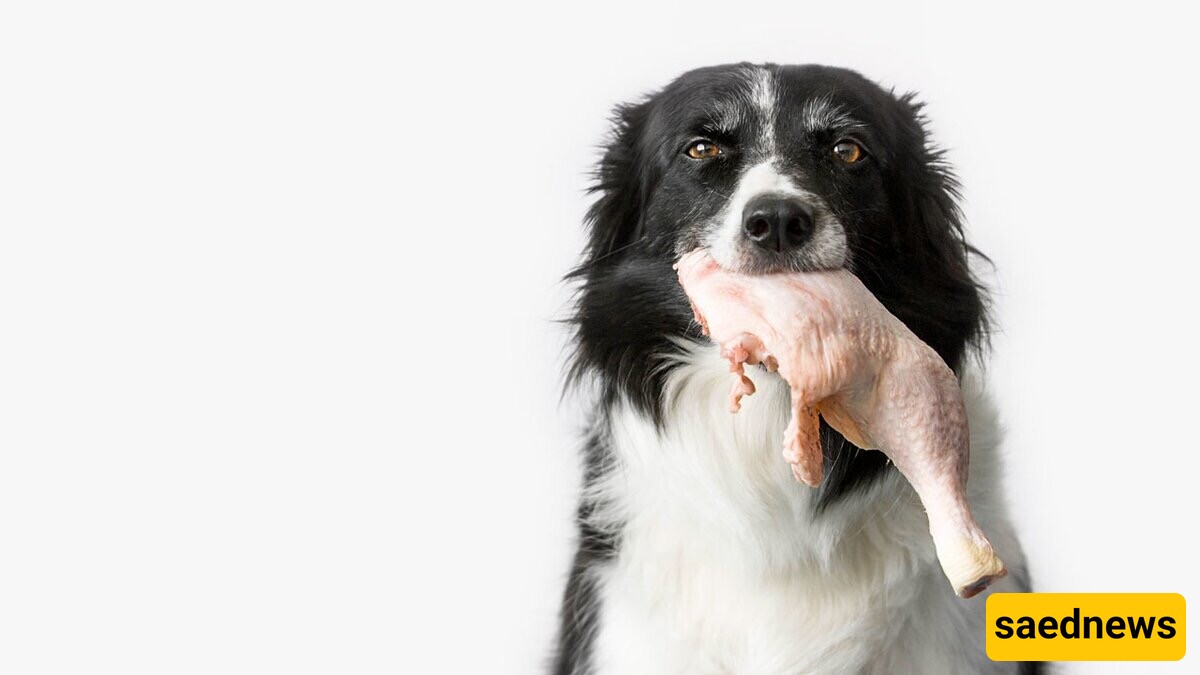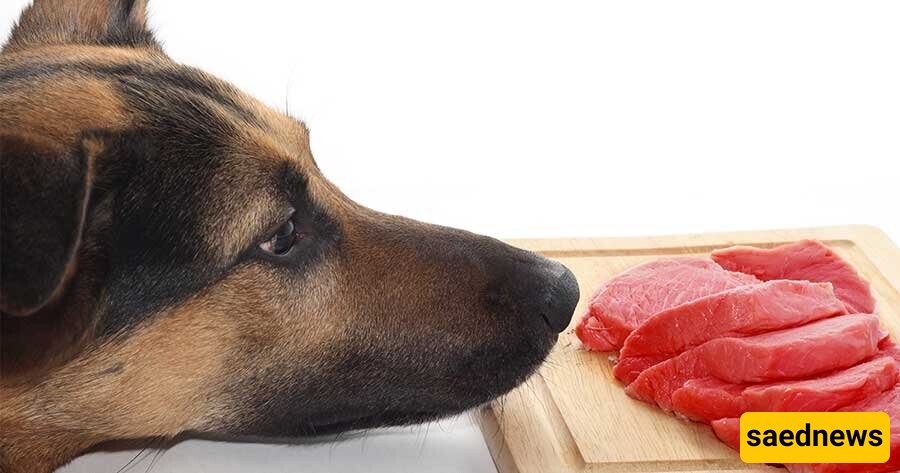Read this article from Saed News to learn everything you need to know about feeding your dog a raw, meat-based diet. This will help you make an informed decision.

Natural or raw foods are those found in agricultural lands. These foods exist in nature and spoil if not frozen, differing from the dry components used in extruded dog food.
A raw diet refers to any diet that mainly consists of uncooked meat. This includes homemade raw diets (which are not recommended) and commercially available raw diets. Feeding a raw diet requires careful consideration of your dog’s specific health conditions, lifestyle, and age.
Many people mistakenly believe that a dog’s natural diet consists of raw meat and that dogs cannot digest the carbohydrates found in traditional cooked dog food. However, since their domestication thousands of years ago, dogs have eaten food similar to humans. Unlike wolves, domesticated dogs have developed a strong ability to digest carbohydrates. Their digestive and metabolic traits are more aligned with omnivores like humans, meaning they can eat and digest both meat and plant-based foods.

Better Taste – Some dogs may find raw food more appealing. However, a decreased appetite or refusal to eat could also indicate an underlying illness.
Oral Health – Some raw diets claim to improve dental hygiene by reducing bad breath due to the abrasive texture of raw meat against the teeth. However, there is little scientific evidence to support this, and specially designed dry foods are available for dental care.
Food Allergies – Food allergies are rare and often overdiagnosed. The best way to confirm a food allergy is through an elimination diet. If an allergy to an ingredient in traditional dog food is detected, a raw meat-based diet may help manage it.
Smaller Stools – Many dogs on a raw diet produce less waste, likely due to fewer fillers and indigestible components in their food.
Calmer Behavior – Some believe a raw diet can make dogs calmer due to lower carbohydrate levels and fewer additives. However, studies show mixed results—some dogs become more energetic, while others show no behavioral changes. High-quality dry or wet food can also contribute to a balanced temperament.
Improved Digestibility – Raw diets are typically high in protein and fat, making them easier to digest. However, highly digestible diets are not always beneficial, and high-fat foods can increase the risk of conditions like pancreatitis.
While raw diets have benefits, they also pose several risks, including nutritional deficiencies, infections, and digestive issues.
Preparing a nutritionally balanced homemade raw diet is challenging. If you choose to do so, consult a veterinary nutritionist. Commercially prepared "complete" raw diets reduce the risk of nutritional deficiencies. However, you must consider your dog's age and health to prevent complications such as skeletal diseases in growing dogs, kidney problems due to excessive protein, high-fat levels leading to pancreatitis, and other conditions like secondary hyperparathyroidism.
Raw pet food often contains higher levels of harmful bacteria such as Salmonella, E. coli, Listeria, and Mycobacterium (which can cause tuberculosis), compared to cooked pet food. Cooking meat eliminates these pathogens. Even if your dog can tolerate them without getting sick, these bacteria can be transmitted to humans through saliva, feces, or improper handling of raw meat. People with weakened immune systems—such as children, the elderly, and those with underlying health conditions—are particularly vulnerable. Recent studies have also shown that some bacteria found in raw diets are resistant to multiple antibiotics.
Blood tests on cats fed a raw diet have shown elevated white blood cell counts, indicating they are fighting infections rather than having a boosted immune system. Additionally, these cats were found to shed higher levels of Salmonella.
There is no scientific proof that raw bones reduce plaque or periodontal disease in cats and dogs. Chewing hard bones, similar to tough chew toys, can increase the risk of tooth fractures.
Large bone fragments from raw diets can be difficult for dogs to chew and swallow. Some cases of digestive infections, inflammation, and diarrhea have been linked to raw food consumption. If feeding raw bones, be aware that they can break into sharp pieces, potentially causing esophageal or intestinal blockages. Excess calcium and bone fragments can also lead to constipation.
There are many ways to transition a dog to a raw diet, and the best method depends on your dog's age, health status, and previous diet.
For healthy adult dogs under five years old, digestive enzymes can help ease the transition during the first few months.
For older dogs or those with a history of illness, the transition should be gradual, with smaller meals throughout the day.
If you plan to feed your dog both raw food and kibble, serve them separately, as their digestion rates differ. Raw food passes through the digestive system faster than kibble, which requires more effort to break down. Some dog breeds transition more easily than others. For example, smaller breeds often prefer warm food, so it may help to place their food bowl in warm water before serving.
Important Note: Avoid cooking raw food or microwaving it, as discussed earlier. Some dogs may initially refuse to eat raw food due to hesitation or unfamiliarity. However, when hungry enough, they will eventually try it, and once they realize it is safe, they may eat it eagerly. To encourage eating, some owners mix raw food with canned sardines, a spoonful of yogurt, or salmon oil. Since commercial dog foods contain preservatives, cooked fats, and added salts, dogs can develop an addiction to them, making the transition to raw food take at least three days.
Commercial pet foods can create a form of dependency in dogs, making it difficult to remove them from their diet. While raw food is generally recommended, some believe that cooked food may be beneficial for sick dogs.
Nowadays, most dog owners understand that caring for their pets goes beyond grooming and bathing—they must also pay attention to their dog's diet. As a result, many are exploring new food options for their pets. The raw diet is a controversial topic with both supporters and critics. Some believe it is significantly healthier than conventional dog food, while others think it may pose health risks. In this article, we examined both the advantages and disadvantages of feeding dogs a raw diet.

